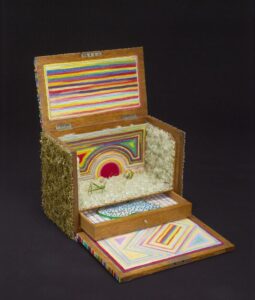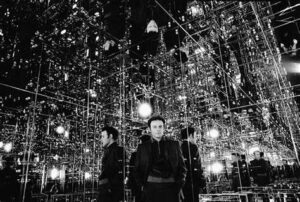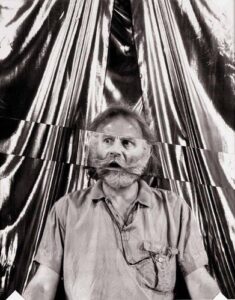Lucas Samaras is a well-known Greek-American artist known for his diverse body of work encompassing sculpture, photography, painting, and performance art. Born on September 14, 1936, in Kastoria, Greece, Samaras immigrated to the United States with his family at a young age. Dies on 7th March 2024
Samaras gained prominence in the 1960s as part of the burgeoning avant-garde art scene in New York City. He became associated with the Neo-Dada and Fluxus movements, known for their experimental and interdisciplinary approaches to art-making. Throughout his career, Samaras has explored themes of identity, transformation, and the human psyche, often incorporating elements of self-portraiture and introspection into his work.
One of Samaras’s most famous series is his “Auto-Interviews,” in which he poses questions to himself and responds in a stream-of-consciousness manner, blurring the lines between reality and fiction. He is also known for his “Box” sculptures, intricate and often unsettling constructions that contain mirrors, objects, and other materials, inviting viewers to contemplate their own reflections and perceptions.
Samaras’s work has been exhibited extensively in major museums and galleries around the world, including the Museum of Modern Art (MoMA) in New York, the Whitney Museum of American Art, and the Art Institute of Chicago. He continues to be recognized as a pioneering figure in contemporary art, known for his bold experimentation and boundary-pushing exploration of the human condition.
To go more in details and the main features of his work….



Lucas Samaras is known for his eclectic and innovative approach to art, which encompasses various mediums and techniques. Here are some characteristics and exceptional artworks that exemplify his practice:
- Exploration of Identity and the Self: Throughout his career, Samaras has been deeply interested in the exploration of identity and the self. Many of his artworks, particularly his self-portraits, delve into themes of introspection, transformation, and the human psyche.
- Experimentation with Materials and Techniques: Samaras is renowned for his experimental approach to materials and techniques. He has worked with a wide range of mediums, including sculpture, photography, painting, and performance art. His willingness to push the boundaries of traditional artistic practices has led to the creation of visually striking and conceptually rich artworks.
- Use of Mirrors and Reflections: Mirrors feature prominently in Samaras’s work, serving as a recurring motif that invites viewers to engage with their own reflections and perceptions. His “Mirror” series, which includes sculptures and installations incorporating mirrors, explores the relationship between the viewer and the artwork, blurring the boundaries between reality and illusion.
- Auto-Interviews: One of Samaras’s most famous series is his “Auto-Interviews,” in which he poses questions to himself and responds in a spontaneous and unfiltered manner. These interviews offer insights into Samaras’s creative process and philosophical inquiries, revealing his wit, humor, and introspective nature.
- “Room No. 2” (1966): This iconic installation by Samaras is a fully immersive environment consisting of a small, mirrored room filled with various objects and furnishings. Visitors are invited to enter the room and interact with their own reflections, creating a disorienting and introspective experience that challenges perceptions of space and identity.
- “Photo-Transformations”: Samaras’s “Photo-Transformations” series features manipulated self-portraits in which he physically alters the surface of photographic prints using techniques such as scratching, painting, and collage. These transformative interventions imbue the portraits with a sense of distortion and fragmentation, reflecting Samaras’s interest in the mutable nature of identity and perception.
- “Chair Transformation Number 20” (1969): In this sculptural work, Samaras transforms a simple wooden chair into a surreal and whimsical object by covering it with hundreds of multicolored pins. The chair’s surface becomes a tactile and visually captivating terrain, inviting viewers to reconsider the ordinary object in a new and unexpected light.
Overall, Lucas Samaras’s work is characterized by its bold experimentation, psychological depth, and exploration of the boundaries between reality and illusion. Through his diverse body of work, he continues to challenge viewers to question their perceptions and contemplate the complexities of the human experience.

